

 |
||||||||||||||||||||||
|
||||||||||||||||||||||
A while back, I tested the mid-sized, 7x32 version of these Endurance ED Marine binoculars from Hawke Sport Optics, which stood out for me for a number of reasons, but chiefly it was because they buck the trend of the typical Marine binocular by using roof prisms with a centrally located focus wheel instead of the much more common porro prisms with a focus free system whereby you have to adjust a diopter on each of the eyepieces if you need to change the focus.
Apart from breaking with tradition, I feel this change did not bring with it any major, deal breaking negative aspects to it's marine binocular credentials.
On top of this, I feel these changes also opened up the binoculars to being an even more versatile instrument, which because of the lower 7x magnification (which is now rare), I found them to be an excellent choice as a mid-sized forest, backyard birding and general wildlife binocular.
In this review, I will try not repeat myself too much by going into detail as to the reasons why all these factors combined to make them such a great and versatile binocular, rather I encourage you to take some time to read the full Hawke Endurance ED Marine 7x32 Binoculars Review and or if you prefer, take a look at the video I made about them below which covers all these main points, components and main features.
Thus the versatility and performance of the 7x32 binocular got me thinking that it would also be very interesting to try out the 7x50 version and see what the increased light gathering abilities of the larger 50mm lenses would bring to the table.
So in this Hawke Endurance ED 7x50 binoculars review, I am going to focus on the main reasons why I decided to also try out the 7x50 version, what this particular configuration brings to the table and the main differences between these and the 7x32 version.
This I hope will help you decide which version is right for you and indeed why and for what reasons a 7x50 binocular like these could be the ideal choice for you:
Main Features & Specifications:
Shape & Design
Theses Hawke Endurance ED's are very different to your typical marine binocular and the most obvious departure from the norm is in their overall body shape and design:
Most marine binoculars (Like the Fujinon Polaris 7x50 FMTRC-SX Binoculars pictured with these above) have the more traditional looking binocular shape with the eyepieces set closer together than the objective lenses, whilst these Hawke's have them set in-line with each other.
This difference in shape is down to the different type of prisms used inside them: Hawke have decided to use roof prisms, whilst most traditional marine binocular opt instead for porro prisms.
Later on in this review in the optics section I go over what impact this has in terms of the image quality, but in terms of their body shape, it is obvious to see that the advantage of this design is you end up with a far more compact shape.
Now if you are planning on only using the binoculars from a static point, like onboard a boat or a yacht, the larger shape of a traditional porro prism 7x50 marine binocular is of no real consequence. Indeed I find the usual design of most porro prism binoculars to be very comfortable and natural to hold onto and storage on the vessel is not usually an issue.
However, if you are also looking to also use the binocular in other areas, like taking them along for a walk with you. Be that either once you have moored up for the day or indeed back at home, having a smaller instrument that is easier to carry about with you is obviously an advantage.
Exterior Rubber Armor
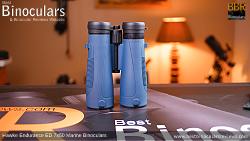 Just like the 7x32 version, the rubber coating used by Hawk is comparatively hard and thin, especially when I think of many other marine binoculars I have used in the past.
Just like the 7x32 version, the rubber coating used by Hawk is comparatively hard and thin, especially when I think of many other marine binoculars I have used in the past.
Harder rubber armors like this can be a little longer lasting in my experience, but thicker, softer rubber coatings are usually more tacky and offer more grip, which in a wet marine environment is a desirable feature.
So in terms of their specific marine credentials, this is perhaps one area where I would have made a change.
Waterproof
The Hawke Endurance ED 7x50 Marine binoculars have a IP67 waterproof rating, meaning that samples are immersed for at least 30 minutes while under 15cm to 1m of water and have proven to remain water tight.
These seals also prevent tiny particles like dust or sand from being able to enter they system which is also very important and something that is often not thought about.
This means you probably shouldn't take them scuba diving with you, (is there such a thing as binoculars for scuba diving and snorkeling? If not... maybe they should or could be?) but in combination with the included floating neck strap these should survive if you accidentally drop them overboard.
I tested these during winter, so unlike the 8x32 version, I did not take these swimming with me (see image below), but with their guarantee, I am pretty sure these would perform as well.
Fog Proof
During manufacture, all the air inside the instrument is purged and replaced with nitrogen. This moistureless gas prevents the internal glass surfaces from fogging up which easily happens with unsealed and unprotected instruments when you get rapid temperature changes. As with the waterproofing, in a marine environment this is another important feature.
Hinges and Inter-Pupillary Distance (IPD) Adjustment
The 7x50 Hawke Endurance ED Marine binocular is advertised as having an IPD (Inter-Pupillary Distance) range of 55mm to 75mm (2.2 - 3"), which after measuring the distance between the centers of the ocular lenses, first with the hinge fully closed and then fully opened, I found to be a little inaccurate as the measurements I got were 60mm to 75mm.
For most users this should not be a problem, but is something to make sure of (measure the distance between your eyes) if you feel that you have particularly close-set eyes.
The hinge itself felt nice and robust on my sample and opened and closed with a good level of resistance and thus I have no further comments in this area.
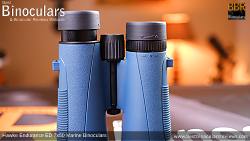 Eyecups& Eyepiece Housings
Eyecups& Eyepiece Housings
The Fujinon Polaris 7x50 FMTRC-SX Binoculars, like many (if not most) other marine binoculars use the more simple system of folding rubber eyecups to alter the eye-relief.
This system works and can be a little more comfortable than many twist-up/down eyecups like which you get on these Hawke binoculars, but they are not able to fine tune the level of eye-relief and I have found can sometimes perish along the folding line.
Thus, I feel this is one area where these have an advantage, which along with the very long 21mm of eye relief make thee an excellent option if you wear glasses, which at sea or on a lake can often mean sunglasses. More Info: How To Use Binoculars With Glasses: Eye-relief & Eye-cups Explained.
Central Focus vs Fixed Focus
The next major deviation of these versus the typical porro prism 7x50 binocular is the Hawke Endurance ED Marine binoculars have a centrally located focus wheel whereas most porro prism marine binoculars don't actually have a focus wheel at all, rather they use a separate diopter adjuster onto each of the eyepieces.
This system is commonly and to my mind erroneously referred to as a "Fixed or Auto Focus" system or something along those marketing jargon lines! I think a better term is focus free binoculars or individual focus as once you have adjusted the diopters on each of the eyepieces to match your particular eyesight, the view will remain sharp and in focus from usually around 20 meters away to infinity and no further adjustments are ever required.
This system does have an advantage as once you have set it up, there is less to do and it makes the binocular easier to use with just one hand (something that you may need to often do when steering a yacht for example).
The major negative point to this system is that they have a very long minimum focus distance. Out on a boat or yacht when you are looking at objects far off in the distance, this is not an issue and which is why for a specific marine binocular this is used.
However, if you also want to use this type of binocular for other activities, like for example back home, or even on the boat when for example something like a bird or dragon fly perches on the bow or the end of your fishing rod, or you are tied up next to the bank and want to observe waterbirds at close range, then this is far from ideal and which is where the central focus wheel binocular like the Hawke would be better.
Focus Wheel & Focussing
Speaking of the focus wheel, I measured the diameter to be 26mm and it is 25mm long.
For a full-sized binocular, this is a little on the small side compared to the average. Indeed it's diameter is less than the one used on the 7x32 Hawke Marine which is interesting.
In normal conditions and for most size of hands this relatively small difference should be of no consequence, but I do feel that if you were out in a storm in very cold weather wearing thick gloves, a larger wheel would make it easier to locate and accurately adjust.
Worth highlighting as it is a sign of quality is that the wheel itself is made from metal and not plastic like many are these days. However, another small issue is I would have like to have seen a rubber track along the top of the wheel (e.g.: Hawke Frontier ED X binoculars) which would improve grip. Again in normal conditions this is no issue at all, but as a marine binocular which I can see being used in cold, wet and windy conditions, it could help.
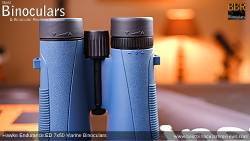 Diopter Adjustment
Diopter Adjustment
Like most standard roof prism binos, these have a ring located on the right eyepiece that is used to adjust the relative focus between the two barrels and thus you are able to compensate for any difference in vision between your left and right eyes.
Hawke indicates what range you can adjust, so I can't comment, but can say that the ring had a good level of friction to it and is not too obvious, and thus even though it is not lockable (the best ones are), once you have calibrated your binocular, it should not move too easily by accident.
Tripod Adaptable
On a moving platform like a boat, there is probably no need to mount your binocular onto a tripod.
However, as the 7x50 combination is commonly used for astronomy I was glad to see that the Hawke Endurance ED Marine 7x50 binoculars are Tripod Adaptable and that they use the usual ¼ thread under the dust cap on the hinge which will accept most standard tripod adapters.
Rating for Body Construction Quality: 8/10
Weight
At 31.2oz (885g) these Hawke Endurance 7x50 binoculars are a little heavier than your typical 8x42 binocular, but on a par or under the weight of many 50mm roof prism binoculars (e.g. the Swarovski EL 10x50 weighs 35.2oz).
Where there is a big difference is if you compare them to a quality 50mm porro prism binocular:
Dimensions
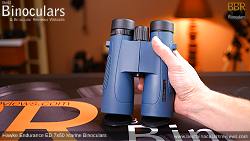 As I have already spoke about how the roof prism design means that compared to most other marine binocular that almost always use porro prisms, these are far more compact.
As I have already spoke about how the roof prism design means that compared to most other marine binocular that almost always use porro prisms, these are far more compact.
Compared to other 50mm roof prism binoculars these are still on what i would describe as the smaller side of average. Indeed apart from the larger lenses and perhaps being a little longer, their outer dimensions are not that far removed from most 42mm binoculars.
For storage on your boat or yacht this size difference is probably not that important, but if you also want to use the binocular once you go ashore or also take them home with you and use them for general use, then i do think this feature becomes important.
BBR Rating for Body Stats compared to 50mm Bins: 9/10
Currently the most common configuration for a binocular is 8x42 (What do Binocular Numbers Mean) as it provides a nice balance between a whole bunch of factors.
This is great for a general use, all-rounder, but should you needs be a little more specific, sometimes it makes sense to alter this configuration to get a better result:
Image Stability
So firstly by lowering the magnification from 8x to 7x, it makes the image or view just that bit easier to keep still and shake free. On the water, this is obviously an advantage and this is probably the main reason why most marine binoculars have a 7x magnification and not higher (even though viewing distances are often quite high).
A more stable image is not only good when out at sea or on a lake, with a high magnification and image shake, it can be hard to see fine details, buy by lowering the power, even though the object you see is smaller, I find that I can often notice more fine details because the view is more steady.
Field Of View
A lower magnification or less zoomed-in image means you get a wider overall picture. This has a number of advantages in many areas, but is especially useful at close range and/or when you are trying to locate a small moving object (birds and other small wildlife for example).
Low Light Performance
Just like a large window that can let in more light than a smaller one, larger objective lenses have the potential to "capture" more light than instruments with smaller lenses.
Then as well as this, the exit-pupils produced by a 7x50 binocular are just over 7mm wide (50 ÷ 7 = 7.143), which is large and usually any larger does not really help as most people pupils do not dilate to more than 7mm. For comparison an 8x42 produces a 5.25mm exit pupil, which is good, but may be found a little wanting for some users in very low light conditions.
The result is, even in very low light when your pupils are full dilated, binoculars like these are able to supply your eyes with more than enough light and thus you perceive a brighter image than through binoculars with smaller exit pupils.
If you are unsure how the exit pupil as well as the quality of the optics affect image brightness, I encourage you to take a moment to check out my complete guide to the exit-pupil.
Fully multi-coated anti-reflection coatings with ED glass lens elements, BaK-4 Silver Mirror coated and phase corrected roof prisms.
So in terms of their main optical components and coatings, apart from the different sized objective lenses, they are all the same as which you find in the 7x32mm version as both use Hawke's H5 Optics System, so I won't repeat myself here as I went over them all in great detail. So here I urge you to take a look at the optics section of the Hawke Endurance ED Marine 7x32 Binoculars Review.
Optical Components Quality Rating: 8/10
Field Of View (FOV)
Measuring 122 meters wide at a distance of 1000m, or 367ft wide @ 1000yds the field of view on the 7x50 Hawke Marine binoculars is good but not excellent, which is a little disappointing as I was expecting more, especially as the 7x32mm Hawke Marine had an extremely wide fov:
| FOV at 1000yds | Close Focus | Eye-Relief | |
| 7x magnification | |||
| Hawke Endurance ED 7x32 Marine | 435ft | 6.6ft | 17mm |
| Fujinon 7x50 FMTRC-SX | 394ft | approx 49ft | 23mm |
| Steiner Navigator Pro 7x30 | 369ft | approx 20ft | 17.4mm |
| Hawke Endurance ED 7x50 Marine | 367ft | 8.2ft | 21mm |
| 8x magnification | |||
| Minox BL 8x33 HD | 421ft | 8.2ft | 17.5mm |
| Opticron Explorer WA ED-R 8x32 | 408ft | 8.2ft | 18mm |
| Hawke Frontier ED X 8x32 | 405ft | 8.2ft | 16mm |
| Opticron Discovery 8x32 | 393ft | 3.9ft | 17mm |
| Swarovski 8x30 CL | 372ft | 9.8ft | 15mm |
| Bresser Pirsch 8x34 | 366ft | 13ft | 17.15mm |
| Opticron Savanna R 8x33 | 366ft | 11.5ft | 20mm |
| Pentax 8x36 DCF NV | 342ft | 9.8ft | 16mm |
| Steiner Predator AF 8x30 | 302ft | 60ft | |
| 9x magnification | |||
| Celestron Granite 9x33 | 378ft | 8.2ft | 14.1mm |
| Pentax 9x32 DCF BC | 351ft | 8.2ft | 16mm |
| 10x magnification | |||
| Swarovski EL 10x32 Swarovision | 360ft | 6.2ft | 20mm |
| Opticron 10x32 Traveller BGA ED | 339ft | 5.9ft | 17mm |
| Pentax 10x30 PCF CW | 288ft | 9.8ft | 18.8mm |
| Opticron 10x32 Traveller BGA Mg | 270ft | 4.9ft | 16mm |
Close Focus
The minimum close focus distance on the Hawke Endurance ED Marine 7x50 binocular is 8.2ft, which is good for a roof prism binocular, but not quite excellent.
However, as I have mentioned if you compare them against most 7x50 Porro prism binoculars that use the double diopter focus system, you can see that these have a MUCH shorter minimum focus distance.
Eye-Relief:
What is excellent is the 21mm of eye-relief and thus I would describe these as having very long eye relief and thus according to these stats should make a good choice should you wear glasses - remember on a boat this can often mean sunglasses.
I tested this by fully twisting down the eyecups and wearing my glasses, I was thus able to take in the full view without any dark rings on the edges. For more check out my article on How To Use Binoculars With Glasses: Eye-relief & Eye-cups Explained.
Optical Stats Rating: 8/10
To help me with my thoughts below, I carefully compared the view through these Hawke Endurance ED Marine 7x50 binocular to the Fujinon Polaris 7x50 as well as my 8x42mm benchmark that I use for all reviews and lastly my Steiner Nighthunter 8x56, which are my go-to low-light binoculars. These comparisons were conducted in good light conditions and then once again in very poor light (it was just at sunset in rainy conditions).
Image Brightness
With their good quality optics, 50mm lenses and 7x magnification that produces a large exit pupil of just over 7mm, I was fully expecting these to perform well in low light and like the 7x32mm version, I was once again not disappointed.
All four binoculars well inseparable in good light conditions, but in poor light the larger lenses and exit pupils on the 50mm and 56mm binoculars meant that I was quite easy for me to see that they all produced a brighter image than my mid-range 8x42.
Overall, the 8x56 Steiner was the "brightest", which became more evident as the light conditions deteriorated, however the difference was not huge and nowhere near as much as the price difference between the two.
Here I think is where the two porro prism binoculars had an advantage over the roof prisms on these Hawk binoculars. A good quality porro prism like which is undoubtedly used in the Steiner and the Fujinon is able reflect 100% of the light and thus there is zero loss.
These and all Hawke Endurance binoculars use silver mirror coatings on their roof prisms which means that they probably have a reflectivity level of between 95% to 98%, which is very good, but cant match the 100% of a good porro.
It is just a pity that Hawke don't use dielectric coatings instead which has a reflectivity of more than 99% and am sure they would perform even better than they did. Even so at this price range the low light performance of these is excellent.
Contrast & Color Reproduction
With a very bright view, the colors can sometimes feel a little washed out, but this is not the case here as I would describe the colors you see through the 7x50 Hawke Endurance ED Marine as a vibrant version of true to life.
Likewise a brighter view can mean that make an image feel flat and without contrast. Once again, i though the Hawk performed well with a good variation between the dark areas and highlights.
Color Fringing
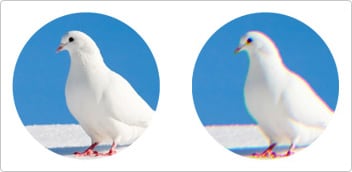 These Hawke Endurance ED Marine 7x50 Binoculars use ED glass elements in their lenses, which can decrease chromatic aberrations that cause color fringing so long as the rest of the optical system is well designed.
These Hawke Endurance ED Marine 7x50 Binoculars use ED glass elements in their lenses, which can decrease chromatic aberrations that cause color fringing so long as the rest of the optical system is well designed.
In this case, it obviously is, because the level of fringing that I observed was very minimal and I would rate these as excellent in this area.
Distortions, Image Flatness & Softening
Also to point out that I was never aware of any other types of distortions or undesired curvature of the image and once focused on an object in the middle of the view, the view through my sample Endurance ED looked perfectly flat and remained in focus from edge to edge.
As is almost always the case, right at the edges of the view there is a certain level of image softening (vignetting), the level on these was extremely minimal and so once again I rate these as excellent in this area, especially when you consider their price bracket.
Conclusion
Overall these Hawke 7x50 Endurance ED binoculars produce an excellent quality of view with the highlight being their performance in low light conditions when compared to your average 8x42.
Image Quality Rating 8/10
These Hawke Endurance Marine 7x50 binoculars are suppled with the small level of mostly excellent accessories that goes beyond what I normally see at this price point: This includes a semi-rigid carry case, a soft carry bag that can also be used as a cleaning cloth, a padded neck strap, a separate floating neck strap, objective lens covers, rain-guard, cleaning cloth, guarantee/warranty card and user instructions!
Carry Case - Main Points
Material Carry Pouch
Somewhat like the Maven binoculars I've tested, Hawke also includes a soft drawstring carry bag. Made from a fine material that to me looks similar to that used on most cleaning cloths and thus can be used for cleaning the instrument as well as carrying it. The fact that you also get a carry case and a separate cleaning cloth makes this all the more impressive.
For users like me who usually don't take the case out into the field or those who use a binocular harness, this actually works very well. As a marine binocular I also like the idea as you can easily put it into the bag during the day to give the instrument a little added protection from see spray and the sun.
Cleaning Cloth
Like many other Hawke binoculars that I have reviewed in the past, the included cleaning cloth is one of the best, especially at this price range. Made from a very high-quality microfiber material, it comes with its own pouch and instructions on cleaning. This is especially impressive considering that you also get a carry pouch that can double as a cloth for cleaning!
As good as this all is, I would still recommend that you get yourself a lens cleaning kit for thoroughly cleaning the lenses without the risk of damaging the lenses and their coatings.
Floating Neck Strap
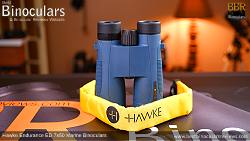 Whilst smaller and less thick that some, you can see by the photos at the top of this review, the included floating neck strap is easily buoyant enough to ensure that your binoculars don't sink to the bottom of the sea should you accidentally drop them overboard.
Whilst smaller and less thick that some, you can see by the photos at the top of this review, the included floating neck strap is easily buoyant enough to ensure that your binoculars don't sink to the bottom of the sea should you accidentally drop them overboard.
Colored bright yellow to make them easier to spot out in the water, they attach to the binocular in the usual way and can be adjusted for length. like the standard strap (see below), I just wish they had used quick release clips which would have made it easier for us to swap between them both.
Standard Neck Strap
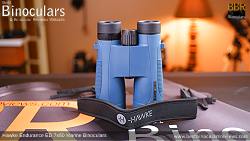 Firstly, I think the fact that Hawke include a standard neck strap is excellent and goes way beyond most. I think it also shows us that they like me also believe that these binoculars are far more than just a marine binocular and that they can be used in a whole range of other uses.
Firstly, I think the fact that Hawke include a standard neck strap is excellent and goes way beyond most. I think it also shows us that they like me also believe that these binoculars are far more than just a marine binocular and that they can be used in a whole range of other uses.
Even though it is quite narrow, the level of padding and overall comfort is very good, which for a relatively small and lightweight instrument, it is more than sufficient.
The strap attaches to the binocular in the standard way with a slider so it can be adjust for length which is good. Unfortunately it does not come with quick release clips which would have been nice, especially as you also get a floating neck strap and thus it would have made it easier to swap between the two.
So overall I would describe this neck strap as very good, but not not quite excellent as it is missing a minor detail, but is still at the higher end of the spectrum in this price range in terms of the overall quality and function.
Objective Lens Covers
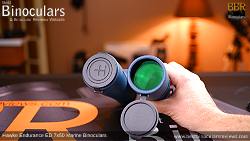 The tethered objective lens covers are in most ways excellent, but at the same time can be a little annoying:
The tethered objective lens covers are in most ways excellent, but at the same time can be a little annoying:
Main Points
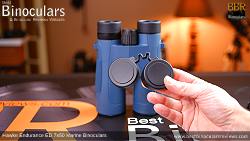 Rain-Guard
Rain-Guard
The rain-guard / ocular lens cover is pretty standard, but what is important to mention here is that it has a good fit over the eye-cups and thus does not come away to easily by accident nor is it too difficult to replace.
Instruction Manual
Hawke includes a set of instructions that goes over all the most important aspects of the instrument including focusing, setting the diopter, IPD settings, and adjusting the eye-cups.
Warranty / Guarantee
Hawke offers their No Fault Lifetime Warranty with the Endurance ED which is excellent and shows they believe in their own products and are willing to back it up.
Extras Rating: 8/10
The table below displays a selection of other binoculars with a 7x magnification that I have reviewed. To view the full results:
open the table in full screen mode.
As a pure marine binocular the Hawke Endurance ED Marine 7x50 binoculars tick most of the boxes and only miss out on a fee very minor details and thus I would suggest that they make a good choice if you are a boat owner looking for a mid-priced instrument that you can take out on the water with you.
However, as with the 7x32 version, where I think they really excel and set them selves apart from the rest is in the versatility.
The much smaller shape and lower weight opens them up to a whole raft of other uses and thus will be of interest to anyone looking for a mid-priced binocular that offers all the benefits that you get when you combine a very good quality optical system with a lower 7x magnification and large 50mm lenses:
Reviewed by Jason Whitehead for Best Binocular Reviews
|
Main Specifications & Features:

Below are similar pairs of Binoculars that you may also want to have a look at:
Designed with professional marine and fishing industries in mind, these 7x50 Fujinon binoculars also make excellent wide-field astronomy binoculars...

General Price Range: (3/6) Mid Price Binoculars
Below is a link that will take you to a page with online retailers in both the US and UK that sell Hawke 7x50 Endurance ED Marine Binoculars this page makes it easy to compare prices and then to buy from your preferred option:
|
Buy & Compare Prices for the Hawke 7x50 Endurance ED Marine Binoculars |
||
US Shoppers |
Canadian Shoppers |
UK Shoppers |
Deutsch Shoppers |
Aussie Shoppers |
Indian Shoppers |